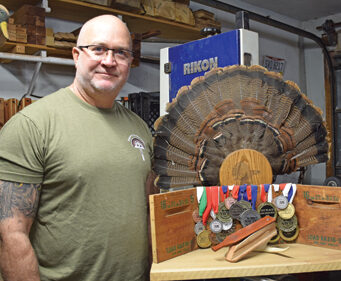Turkey hunters nationwide ‘call’ on Rupert
Resident crafts award-winning calls
by Chris Studor
When turkey hunting season opens April 1, most hunters will be reaching for their favorite call device to attract a gobbler or hen.
With more than 30 years experience making turkey calls, Hinckley resident Ken Rupert is the person many choose to “call” when looking to purchase a box or pot call.
Not only is the choice of wood types Rupert offers almost unlimited, but in just one three-year period, Rupert won more than 40 awards for both turkey calling and making calls.
“After that many awards, I felt I didn’t have much more to prove and now I just stick to making calls and hunting,” Rupert said.
Last fall, Rupert was scheduled to be a vendor at the Hinckley Holiday Market, however, a few weeks prior to the show, a buyer approached Rupert and purchased just about every call he had made.
Rupert went right back to his workshop making single- and double-sided box calls and pot calls.
“I started carrying a gun when I was 12 years old, hunting with family and friends,” said Rupert. “We hunted deer, elk, bear, water fowl and turkey. My full-time career was working as a manger for Gander Mountain but I was also into woodworking. I’ve met a lot of great people and made many great friends through this hobby. I have also donated many hunting trips working with both youth and veterans.”
Although there are a number of types of turkey calls, the most basic and highly used is the box call, said Rupert. Some box calls are made of separate pieces of wood with the sides of the box being a softer wood fitted into a grooved bottom and a sliding lid usually made of a harder wood. Some woodworkers choose to hollow out one piece of wood to make a box call typically, approximately 1.25 inches deep.
“As the lid slides over the sides of the box friction is created and the sound produced is the result of the grains of the wood rubbing against each other,” said Rupert. “The types of wood I’ve used is almost endless, from common poplar to wormy chestnut, holly, pecan, hackberry, mesquite, persimmon and snake wood. You name it and I’ve usually used it. Sometimes friends will bring me a piece of wood from another state to use.”
For a decorative look on a call box, Rupert takes advantage of any fungus growing on the wood. In a process called wood spalting, the woodworker harnesses the fungus by stabilizing the fungus with the use of cactus juice and colored epoxy to fill in the voids. Spectacular color and lines are the result.
Rupert also makes pot calls, consisting of a shallow, circular wooden or metal pot that holds a round disc. The caller holds a striker about the diameter of a pencil and rubs or scratches the disc to make multiple hen sounds using various pressures on the disc.
The finishing touch on Rupert’s calls is his own laser logo – a white cross with a turkey fan in the background. Hanging from the cross is a special necklace like the one he received from his grandfather years ago, reflecting his philosophy of living a Christian life.
Outdoors and hunting enthusiasts can view Rupert’s work on Instagram
@krupertjr09. ∞
Featured Photo: Hinckley resident Ken Rupert shows off just a sample of the 40-plus awards he’s won for his handmade, custom turkey calls. A completed turkey call box sits in front of the medals. The sound is produced by rubbing the lid over the sides of the box. Photo by C. Studor.

